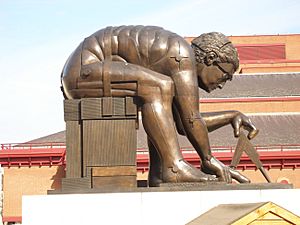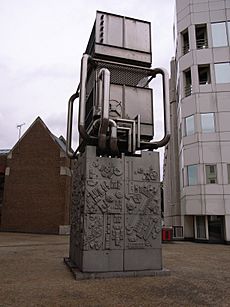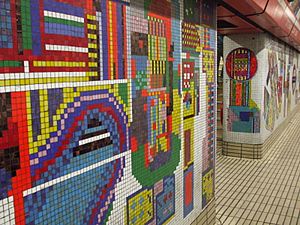Eduardo Paolozzi facts for kids
Quick facts for kids
Sir Eduardo Paolozzi
|
|
|---|---|

Paolozzi's 1995 Newton follows William Blake's 1795 print Newton in illustrating how Isaac Newton's equations changed our view of the world to being one determined by mathematical laws (1995).
|
|
| Born | 7 March 1924 |
| Died | 22 April 2005 (aged 81) London, England
|
| Education | Edinburgh College of Art, University of Edinburgh Slade School of Fine Art, UCL |
| Known for | Sculpture, art |
| Movement | Pop art |
Sir Eduardo Luigi Paolozzi (born March 7, 1924 – died April 22, 2005) was a famous Scottish artist. He was known for his amazing sculptures and graphic art. Many people think he was one of the first artists to create Pop art.
Contents
Growing Up and Early Life
Eduardo Paolozzi was born in Leith, Scotland, on March 7, 1924. His parents were Italian immigrants who ran an ice cream shop. He spent his summers in Italy and grew up speaking two languages.
In June 1940, during World War II, Italy declared war on the United Kingdom. Because of this, Paolozzi was held in a special camp for a few months. Sadly, his father, grandfather, and uncle were also held and later died when their ship, the Arandora Star, was sunk by a German submarine.
After this difficult time, Paolozzi studied art at several schools. These included the Edinburgh College of Art and the Slade School of Fine Art in London.
Time in Paris
From 1947 to 1949, Paolozzi lived and worked in Paris, France. There, he met many famous artists like Alberto Giacometti and Jean Arp. Meeting these artists greatly influenced his own work. He started making sculptures using a method called "lost-wax casting." These sculptures often had interesting surfaces made from found objects and machine parts, which helped him become well-known.
His Amazing Art Career
After his time in Paris, Paolozzi moved back to London. He set up his studio in Chelsea, which was a very busy place! It was filled with hundreds of found objects, models, tools, toys, and books. Paolozzi was curious about everything and loved to use different materials in his art, especially in his collages.
In 1955, he moved with his family to a village called Thorpe-le-Soken. There, he started a design company called Hammer Prints Limited with another artist, Nigel Henderson. They made wallpapers, textiles, and ceramics.
What is Pop Art?
Paolozzi became famous in the 1950s for his bold screenprints and unique sculptures. He helped start a group called the Independent Group in 1952. This group is seen as a very early part of the Pop art movement that became popular in the 1950s.
His collage from 1947, called I was a Rich Man's Plaything, is often seen as one of the first examples of Pop Art. Even though he worked in many different art forms, Paolozzi is most known for his sculptures. His sculptures often looked like real people but had straight, geometric shapes added or removed. Sometimes, the human form was broken down into a cubist style.

Teaching and Working in Germany
Paolozzi also taught sculpture and ceramics at many art schools. He taught at places like the Hochschule für bildende Künste Hamburg and the Royal College of Art. He spent a lot of time working in Germany, especially in Berlin and Munich. He loved Munich and created many of his famous works and ideas there. This included the amazing mosaics you can see at the Tottenham Court Road Station in London.
In the 1970s, he even tried industrial design! He decorated a special set of tableware for a German porcelain company.
His Graphic Art
Paolozzi's graphic art from the 1960s was very new and exciting. He explored what he could do with silkscreen printing. His prints often featured images from Pop culture and technology. Some of his famous print series include:
- As Is When (1965)
- Moonstrips Empire News (1967)
- Universal Electronic Vacuu (1967)
- General Dynamic Fun (1970)
He also used images from popular science books by a German doctor named Fritz Kahn. You can see this in his print "Wittgenstein in New York" (1965) and the series Secrets of Life – The Human Machine and How it Works (1970).
Later Career and Legacy
Paolozzi received many honors for his art. He was made a Commander of the CBE in 1968 and became a member of the Royal Academy in 1979. In 1989, Queen Elizabeth II made him a Knight, so he became "Sir Eduardo Paolozzi."
In 1980, he was asked to create three large tapestries for the Institute of Chartered Accountants in England and Wales. He wanted these tapestries to show "our world of today" in a bold style, like the famous Bayeux tapestries.
He was also given the special title of Sculptor in Ordinary for Scotland in 1986, which he held until he passed away.
In 1994, Paolozzi gave a huge collection of his artworks and many items from his studio to the Scottish National Gallery of Modern Art. In 1999, the National Galleries of Scotland opened the Dean Gallery to show this collection. You can even see a recreation of Paolozzi's studio there, which looks just like his original studios in London and Munich!
In 2001, Paolozzi had a serious stroke, which meant he had to use a wheelchair. He passed away in a London hospital in April 2005.
In 2013, the Pallant House Gallery held a big show called Eduardo Paolozzi: Collaging Culture. It featured over 100 of his works, including sculptures, drawings, textiles, and collages.
Famous Public Artworks
Eduardo Paolozzi created many large artworks that you can see in public places. Here are some of his most famous ones:
- Mosaic murals at Tottenham Court Road tube station in London. These are his biggest works and cover platforms, passages, and escalator entrances.
- Cover artwork for Paul McCartney's album Red Rose Speedway.
- Ceiling panels and window tapestry at Cleish Castle.
- Piscator sculpture, which used to be at Euston railway station in London.
- Cast aluminium doors for the University of Glasgow's Hunterian Museum and Art Gallery.
- Bronze sculpture Newton after Blake (1995) in front of the British Library.
- The Manuscript of Monte Cassino, a sculpture with an open palm, a limb, and a human foot, located on Leith Walk in Edinburgh.
- Head of Invention sculpture in front of the Design Museum in Kensington, London.
- Sculpture A Maximis Ad Minima in Kew Gardens in London.
- Mosaics in Redditch Town Centre.
- Athena sculpture in the foyer of the John McIntosh Arts Centre at The London Oratory School.
- Faraday sculpture at the University of Birmingham.
- The Artist as Hephaestus, a sculpture that was on High Holborn in London.
Other Interesting Work
- Eduardo Paolozzi acted in a film called Together in 1956. He played a character who could not hear or speak.
- A photograph of Paolozzi's large, strong right hand was chosen by Lord Snowdon for the cover of his book Photographs by Snowdon: A Retrospective.
His Writings
Paolozzi also wrote several books about art and his ideas:
- Metafisikal Translations (1962)
- Eduardo Paolozzi (1971)
- Junk and the New Arts and Crafts Movement (1979)
- Recurring themes (1984)
Images for kids
-
Scotland's Early People, National Museum of Scotland. These sculptures include display cases for ancient artifacts.
See also
 In Spanish: Eduardo Paolozzi para niños
In Spanish: Eduardo Paolozzi para niños
- Art of the United Kingdom
- Modern sculpture
- Stuart Sutcliffe








